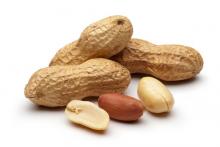SAN FRANCISCO – Sublingual immunotherapy desensitized 11 children to peanut allergies in a double-blind, placebo-controlled trial.
When challenged with peanut after a year of treatment, they tolerated a median of 1,710 mg (about seven peanuts), while 7 children in the placebo arm tolerated a median of 85 mg (about one-fifth of a peanut), a 20-fold difference (P = .011).
The results were so impressive that the interim analysis was cut short to switch placebo children to active therapy, said senior investigator Dr. Wesley Burks, professor of pediatrics and chief of the division of pediatric allergy and immunology at Duke University Medical Center, Durham, N.C.
But however promising these results, and those of other immunotherapy trials, Dr. Burks cautioned that additional efficacy and safety verification are needed.
In some immunotherapy trials, children who seemed to tolerate gradual exposure and desensitization to their particular allergens had unexpected anaphylactic reactions, especially if they came down with a viral illness. A significant proportion of children also can't tolerate oral immunotherapy, he said.
Those points are often missed in news reports that suggest immunotherapy cures food allergies. Until more is known, immunotherapy "is not the right thing to do right now. We don’t put people on immunotherapy unless it’s in a study," he said.
Children in the trial were aged 1- to 11-years-old and had histories of peanut reactions plus elevated peanut IgE levels.
Treated children were dose escalated over a period of 6 months to a total of 2,000 mcg of peanut protein daily, then maintenance dosed for the next 6 months. The peanut extract was placed under their tongues, held for a couple minutes, then swallowed; 2,500-mg peanut challenges came at the 1-year mark.
Although the median was 1,710 mg, "there was a pretty wide range in how much [treated children] tolerated," Dr. Burks said, with some able to handle the entire 2,500 mg, others only 200 mg.
Peanut-specific IgE increased over the first 4 months of treatment (P = .002), then steadily decreased over the remaining 8 months (P = .003). Peanut-specific IgG4 increased over the entire year of therapy (P = .014).
"Their skin-prick tests [also] went down in the first 6 months [of treatment] and stayed down" versus placebo, Dr. Burks said. Treated children had wheal sizes significantly smaller than children in the placebo group (P = .020).
The findings "suggest a significant change in the allergic response," Dr. Burks concluded.
Dosing side effects were mostly oropharyngeal and seldom required treatment.
Children in the placebo group were switched to sublingual therapy following the peanut challenges. After a year of treatment, five of the seven now tolerate 2,500 mg of peanut, with the other two tolerating between 1,500 and 2,000 mg, Dr. Burks said.
Dr. Burks disclosed that he is a consultant for Actogenix, Dannon, Intelliject, McNeil Nutritionals, Novartis, Schering-Plough (now a part of Merck), and Nutricia. He is a minority stockholder in Allertein Therapeutics and Mast Cell Pharmaceuticals.



